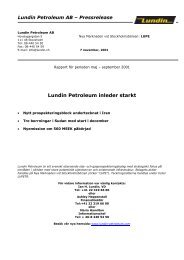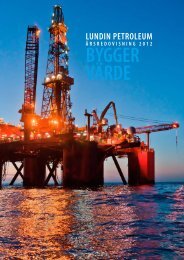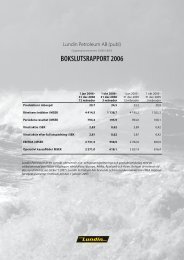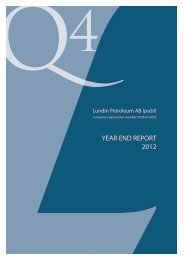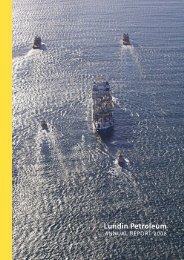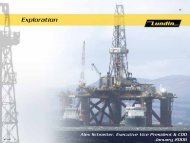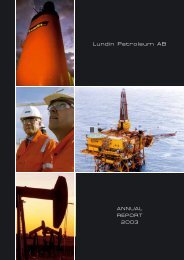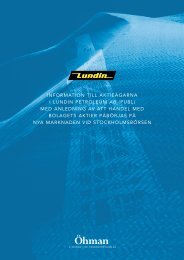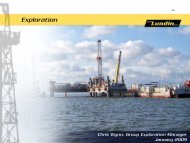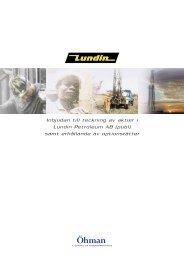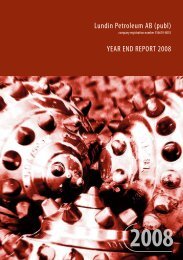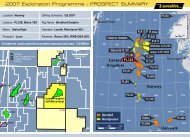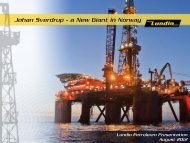Annual Report 2005 (6 MB) - Lundin Petroleum
Annual Report 2005 (6 MB) - Lundin Petroleum
Annual Report 2005 (6 MB) - Lundin Petroleum
Create successful ePaper yourself
Turn your PDF publications into a flip-book with our unique Google optimized e-Paper software.
UNDERSTANDING RESERVES AND RESOURCES<br />
Resource Classifi cation System<br />
Proved<br />
PRODUCTION<br />
RESERVES<br />
Proved &<br />
Probable<br />
CONTINGENT<br />
RESOURCES<br />
PROSPECTIVE<br />
RESOURCES<br />
Proved, Prob.<br />
& Possible<br />
Commercial<br />
Discovered but not<br />
currently commercial<br />
Exploration prospectivity<br />
> 6 <<br />
Reserves<br />
<strong>Lundin</strong> <strong>Petroleum</strong>, like most companies in Europe, calculates<br />
reserves and resources according to the SPE/WPC defi nition<br />
of petroleum resources. This defi nition was fi rst published<br />
in 1997 by the SPE (Society of <strong>Petroleum</strong> Engineers) and<br />
WPC (World <strong>Petroleum</strong> Congress) in an eff ort to standardise<br />
reserves reporting.<br />
Reserves are defi ned as those quantities of petroleum which<br />
are anticipated to be commercially recovered from known<br />
accumulations from a given date forward. Estimation of<br />
reserves is inherently uncertain and to express an uncertainty<br />
range, reserves are subdivided in Proved, Probable and<br />
Possible categories. <strong>Lundin</strong> <strong>Petroleum</strong> reports its reserves as<br />
Proved plus Probable reserves, also abbreviated as 2P.<br />
<strong>Lundin</strong> <strong>Petroleum</strong>’s reserves are calculated using forward<br />
projections of production levels, work programmes and<br />
the associated capital investment, and operating cost<br />
levels. From these projections the last year of economic<br />
production is calculated, given an assumed oil price scenario.<br />
The aggregate production until this economic cut off point<br />
constitutes the reserves. This year <strong>Lundin</strong> <strong>Petroleum</strong> has<br />
used a long term oil price scenario of USD 35 per barrel for<br />
this calculation.<br />
Each year <strong>Lundin</strong> <strong>Petroleum</strong>’s reserves base is certifi ed by<br />
an independent reserves certifi er. Over the last couple of<br />
years Gaff ney, Cline and Associates (GCA) has performed<br />
this service. GCA is one of the largest independent reserves<br />
certifi ers in the world and this year GCA certifi ed 146.1<br />
MMboe (million barrels of oil equivalent) of 2P oil and gas<br />
reserves net to <strong>Lundin</strong> <strong>Petroleum</strong>. This is an increase of<br />
12 percent compared to last year’s reserves and <strong>Lundin</strong><br />
<strong>Petroleum</strong> replaced last year’s production by 126 percent.<br />
Contingent resources<br />
In addition to its certifi ed reserves, <strong>Lundin</strong> <strong>Petroleum</strong> has a<br />
number of discovered oil and gas resources which currently<br />
do not classify as reserves. According to the SPE/WPC these<br />
classify as contingent resources. Contingent resources are<br />
those quantities of petroleum which are estimated, on<br />
a given date, to be potentially recoverable from known<br />
accumulations, but which are not currently considered to be<br />
commercially recoverable.<br />
<strong>Lundin</strong> <strong>Petroleum</strong> has an estimated 131 MMboe of contingent<br />
resources. These resources are not reserves, because further<br />
work is required to mature them. Additional work can be<br />
the drilling of a ‘productivity prover’ in the Heather Triassic,



